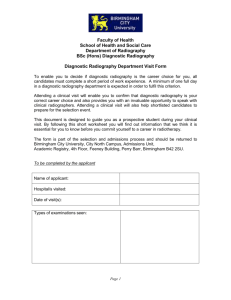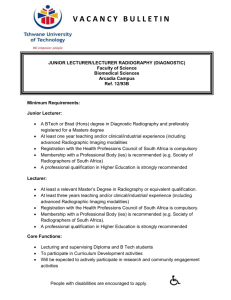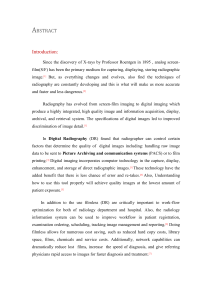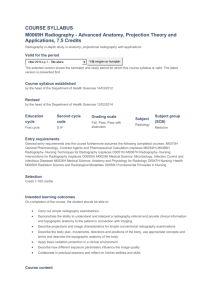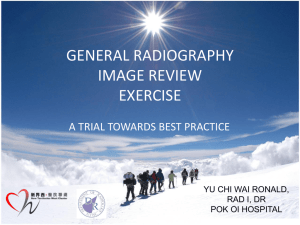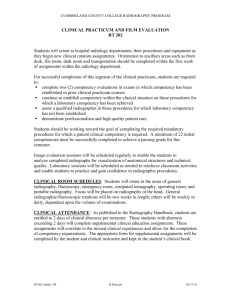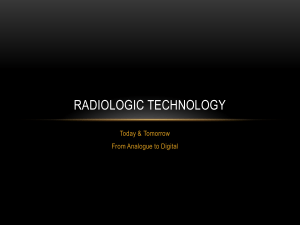Non Destructive Testing - Radiography for Sorting
advertisement
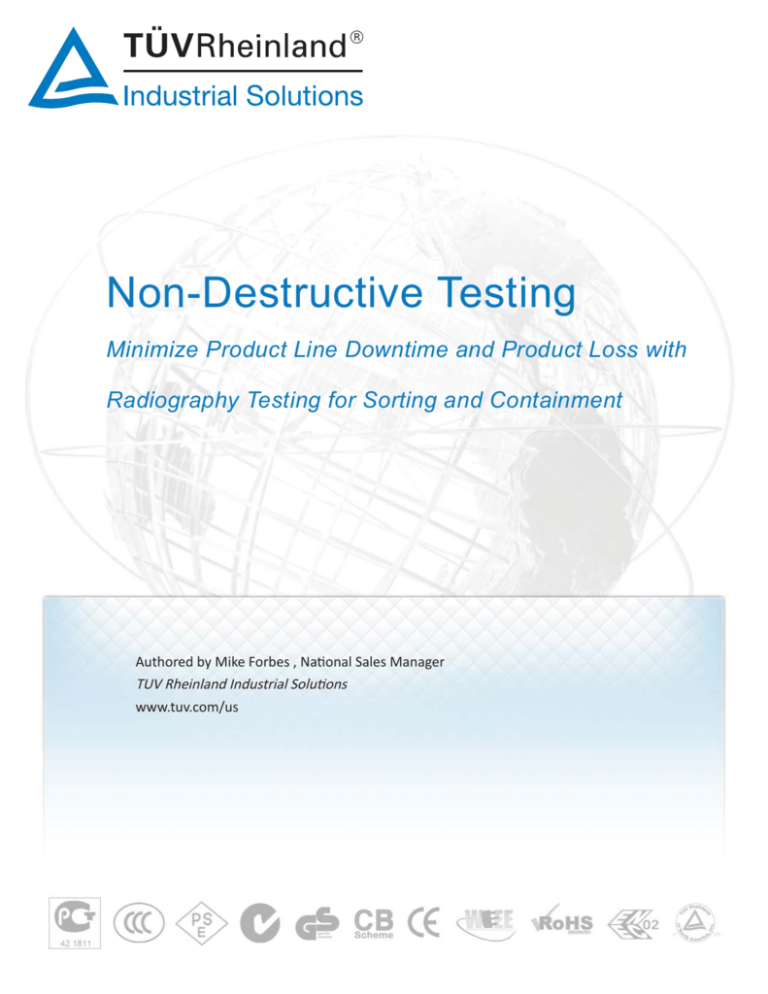
Non-Destructive Testing Minimize Product Line Downtime and Product Loss with Radiography Testing for Sorting and Containment Authored by Mike Forbes , NaƟonal Sales Manager TUV Rheinland Industrial SoluƟons www.tuv.com/us When non-conformances are discovered immediate action is required to contain the flawed product, and to ensure that it is quickly identified, contained and corrected at the suppliers and often times the customers locations. Radiography can deliver a timely solution to problems. In addition to field inspection,at times it makes sense to ship products to containment laboratories for sorting to contain costs. IntroducƟon This whitepaper is the first in a series on Non-Destructive Testing technologies that focuses on Radiography. Despite all the Early Production planning and due diligence in the Pre-Launch Control Plan and careful execution of production issues can occur. While adhering to JIT and Lean Manufacturing principles can lower production costs, the necessitated minimal inventory volumes can magnify the cost of faulty products entering the supply chain. Often, a product defect is not discovered until well after the part is already on trailers, in transit, on the customer’s floor, or in assembled products on vehicles. A team can travel to the where the suspect products are located to provide on-site inspection, sorting and containment services to minimize possible production disruptions. As the recent Japanese earthquake and tsunami have shown, it can only take one missing component to quickly bring an entire production line to a halt. Radiography can be thought of as a solution to keeping a production line running. 1. Why choose Real Time Radiography InspecƟon? Real Time Radiography is a great non-destructive testing method that is capable of viewing a radiographic image in real time without the hinderence of developing film or having to deal with hazardous developing chemicals. It has the capability to magnify the area of interest making the interpretation of a indication a much easier process. This process is called micro focus. When a product has been quarantined or contained, Radiography is a great method that can be utilized to sort the product separating the “flawed suspect” and verifying “good” product. The key factor to utilize realtime radiography for TUV Rheinland Industrial Solutions has been to automate the systems so that through the utilization of a conveyor system in a large 12’ x 12’ leaded cabinet, multiple parts can be run in a continuous process of loading and unloading product making a very cost effective means of sorting product. The viewing process is uninterrupted with only slight delays to mark the suspect product and to separate and remove the defective items. Types of products that can be sorted utilizing this method • • • • • • Aluminum Cost Products Electrical Components- bad connecƟons Enclosed mechanical devices- missing components Find dense material contaminaƟon - in food products and such as screws/metal sharings Circuit boards- bad soderring points - missing components Numerous other nonconformance issues detectable with radiography Non-DestrucƟve TesƟng - Radiography for SorƟng and Containment www.tuv.com/us 2 Real Time Radiography is not without limitations but is a very efficient methodology. Some of the limitations are due to density of products surrounding the area of interest and the permanent record is not as clear as film radiography. However, flawed products can be sorted and further examination can be done using other methods. Regardless of the issue, being able to sort numerous amounts of product in a quick, clean, safe way is very efficient and a cost effective way to salvage products and to keep the supply chain moving without having costly downtime or shutting down a major supplier. 2. Other types of Radiography Computed Radiography Computed radiography (CR) is a technique that captures a radiographic image in storage phosphors for later readout and display. Unlike “prompt-emitting” phosphors used in conventional phosphor-intensifying screens, these storage phosphors retain the latent image which remains stable for a period of time before it decays to a level at which image quality will be adversely affected. This period can range from minutes to days, depending on the screen phosphor material. During this time, the image can be read out with a scanning system, which through the application of appropriate software, digitally reconstructs the radiographic image. The image is read out by scanning it with a red or near-infrared light to stimulate the phosphor, causing it to release its stored energy in the form of visible light. This phenomenon is known as photostimulable luminescence. Like conventional intensifying screens, the intensity of this stimulated luminescence is directly proportional to the number of X-ray photons absorbed by the storage phosphor. Why Consider Computed Radiography? Computed radiography enthusiasts cite a number of attractions: • • • • • • • • • • Greater dynamic range of phosphor plates compared to film, allowing more range in depth of the material being examined. Reduced exposure times and reduced energy requirements. Quicker results without chemical processing. Images on the phosphor plates are scanned, retrieved, and stored digitally. Fewer return trips for reshoots due to artifacts on film or exposure errors. Reduced footprint in the lab for image processing. Decreased archiving facility requirements. No film or associated costs — phosphor plates last thousands of exposures with respectful handling. No photographic chemicals or associated health and environmental concerns. Easier documentation and retention of welder qualifications. CR enables electronic or DVD transmission of inspection reports, as well as simultaneous viewing by people in multiple locations. Non-DestrucƟve TesƟng - Radiography for SorƟng and Containment www.tuv.com/us 3 Gama Radiography Gama Radiography can be used in the laboratory (shooting vault) or in the field. It is used to shoot through thick product 3 inches or greater steel or large parts that are not easily moved or are not portable. This process uses gamma ray radioisotopes to test materials for flaws such as invisible cracks, defects and occlusions in the quality of welds, etc. The advantage of gamma radiography compared to non-nuclear technologies is that it can be done thoroughly and non-invasively (one does not have to cut the material open). It can be done rapidly and in in some cases less expensive to perform. The process is very similar to x-ray radiography in a hospital or x-ray screening of luggage at an airport. The difference is that instead of using x-rays, gamma radiography uses a source that is more penetrating, such as cobalt-60, that is a portable source. Radioisotopes have an advantage in that they can be taken to the site when an examination is required, and no electric power ia available. All that is needed to produce effective gamma rays is a small pellet of radioactive material in a sealed titanium capsule. The capsule is placed on one side of the object being screened, and some photographic film is placed on the other side, The gamma rays, like x-rays, pass through the object and create an image on the film. Just as x-rays show a break in a bone, gamma rays show flaws in metal castings or welded joints. The technique allows critical components to be inspected for internal defects without damage and in place. X-Ray Radiography X-Ray Radiography is a non-destructive failure analysis technique used to examine the interior details of an item. It operates on the principal of dissimilar transmission of X-Rays through different materials. The ability of a material to block X-Rays increases with it’s density. It is this dissimilar transmission of X-Rays through different materials that is utilized to create an image of various contrasts. X-Ray imaging may be accomplished on film. The interior parts of an item are exposed to radiation and the film is then developed through the chemical and drying process. The image is then viewed with a high instensity light and compared to a reference standard. Non-DestrucƟve TesƟng - Radiography for SorƟng and Containment www.tuv.com/us 4 3. Typical Non-DestrucƟve Radiography InspecƟons by Industry Type Automotive Critical Components Foundries/Casting Critical Components Forging Critical Components Food Contamination Welding (Spot Weld) Weld Quality/Failure Electrical Components Crimped Wires / Bad Switches Steel Mills Mixed Material Power Generation Pipeline Corrosion Pharmaceutical Pipeline 4. The importance of selecƟng the best InspecƟon Company as Your Partner in the Time of Need When panic situations occur necessitating containments, a carefully selected partner in inspection can limit exposure to losses and down time. * Accredited agency * Qualified level II Inspectors * Third party certification (report) * Cost effective highly trained personnel * Traceable documentation Non-DestrucƟve TesƟng - Radiography for SorƟng and Containment www.tuv.com/us 5 About TÜV Rheinland Industrial Solutions TÜV Rheinland Industrial Solutions has a long history of providing materials testing and inspection services to global customers. Our portfolio includes a full range of destructive and nondestructive methods, quality control and quality assurance functions, and physical testing. We test, approve and certify materials and products in accordance with both domestic and international requirements and codes. Laboratory and Field Services are ISO 17025 accredited. Mechanical Lab Services are both Nadcap and ISO accredited. TUV Rheinland Industrial Solutions provides eemergency rapid response sorting and containment services. Our C.E.R.T (Containment Emergency Response Team) program uses Non-Destructive testing and Field based inspection methods to minimize supply chain disruptions and protects against production shut-downs. Our team is comprised of certified inspectors, who are readily deployable nationally and internationally, to respond to suspected quality issues throughout the supply channel. Field-based inspection services are available for industries including chemical, petrochemical, power generation, food processing, pulp and paper mills and general manufacturing. In addition, services are available to government agencies, storage facilities, architectural/engineering companies and education facilities. Ask us about our Containment Emergency Response Team (C.E.R.T.) developed to minimize supply chain disruptions and protect against production shut-downs. For more information on TÜV Rheinland Industrial Solutions or to start a project, please visit www.tuv.com/us or call us toll free at 1-800-748-0208 Non-DestrucƟve TesƟng - Radiography for SorƟng and Containment www.tuv.com/us 6
